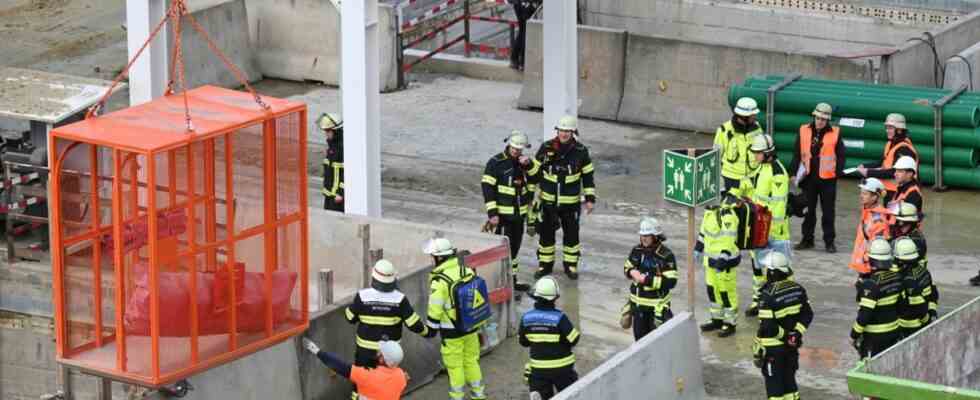Sirens and blue lights startled people in downtown Munich early on Friday afternoon: almost a dozen fire brigade vehicles sped through the streets and gathered behind the town hall at Marienhof. Of course, there was no reason to worry: during an exercise, the rescue workers simulated an emergency on the tunnel construction site for the second main S-Bahn line. On the one hand, the cooperation between the emergency services and the construction companies involved should be rehearsed. On the other hand, it was about playing through the processes in a place that poses new challenges even for the professionals of the local professional fire brigade.
At the Marienhof, the square is being dredged for a new S-Bahn station, located around 42 meters below the surface of the earth, it will be Munich’s future low point. Down there, according to the scenario designed for the firefighters, a worker was trapped under an 18-ton excavator. The task of the rescue workers: free the man, provide first aid and transport him to the top.
The fire brigade was alerted shortly after 2 p.m. because of the alleged industrial accident underground, a few minutes later the first sirens could be heard, then a column of vehicles was already approaching through Dienerstraße. Normally, ambulances and emergency medical vehicles are also part of the entourage, but in this case none were ordered to use them so as not to unnecessarily burden the real rescue service. Half a dozen fire engines eventually drove through the open gate, with the rest waiting outside in case they were needed.
Fire trucks drive through the gate onto the construction site.
(Photo: Stephan Rumpf)
Some emergency services only have the role of spectator.
(Photo: Stephan Rumpf)
The first points could already be ticked off upon arrival at the site: Are the signs at the construction site entrances correct? Have the emergency services been instructed correctly? Have all the requirements for an emergency been implemented? In an emergency, the firefighters not only have to find the quickest way to the scene of the accident – they also have to take special precautions when working underground: They are registered and equipped with location tags and oxygen self-rescue devices.
Inside the site, which is protected by a four-metre-high noise barrier, there was a brief briefing at a collection point, then the first troops and their equipment disappeared down a flight of stairs in the depth of a shaft. At the same time, a man-high lattice cage was attached to a crane with a chain and lowered to the bottom of the construction site through another shaft – a special rescue cage that is kept available especially for emergencies on the construction site. This was used, for example, to test the extent to which the fire brigade can use resources that are already available on site and whether the communication between emergency services and construction site workers works. The radio communication between the firefighters was also tested.
A special rescue cage was lowered into the depths.
(Photo: Stephan Rumpf)
However, it is questionable whether the findings of the construction site exercise can be transferred when the main line is put into operation. On the one hand, the first S-Bahn trains will not run through the new tubes for at least 15 years – a lot can change by then. On the other hand, Deutsche Bahn completely revised the safety concept for the second main route three and a half years ago: At that time, four rescue shafts that were planned for the evacuation of passengers in the event of an incident in the tunnel were deleted without replacement.
As project manager Markus Kretschmer explained back in July 2019 when presenting the new plans, a new EU directive enables a procedure to deviate from the previously planned rescue concept. Until then, only two separate tunnel tubes for the S-Bahn had been planned on the route between Leuchtenbergring and Laim; now a third tube has been installed between the S-Bahn tunnels and is intended to serve as an escape and rescue route.
During the replanning, nothing had to be changed in the underground route for the S-Bahn. The new tube, around four meters wide, was simply fitted in between. A passage between the S-Bahn tunnel and the escape tube is then planned at a distance of less than 350 meters; through which the passengers should be able to flee in the event of an accident or a fire and walk to the next S-Bahn station. Lock chambers at the emergency exits should ensure that the escape routes remain smoke-free. The rescue shafts that were abandoned at the time were up to 600 meters apart, and then the passengers would have had to climb stairs more than 40 meters to the surface.
The future escape and rescue tunnel should also be able to be used for maintenance work, but it was not suitable for the underground use of rescue vehicles, it was said at the time. In view of the fact that, in an emergency, the emergency services have to walk into the tunnels with their equipment and equipment, Friday’s exercise was at least a small indication of what to expect or what can be improved.

